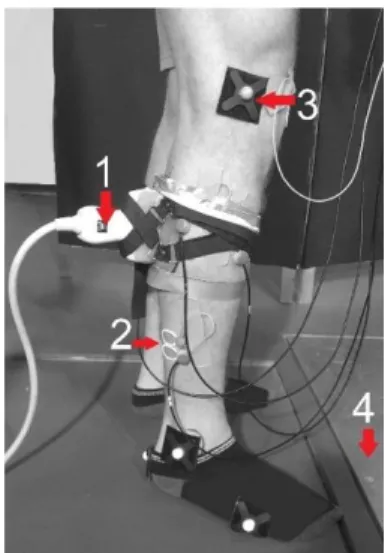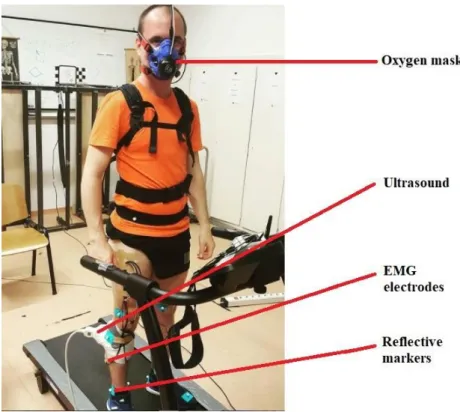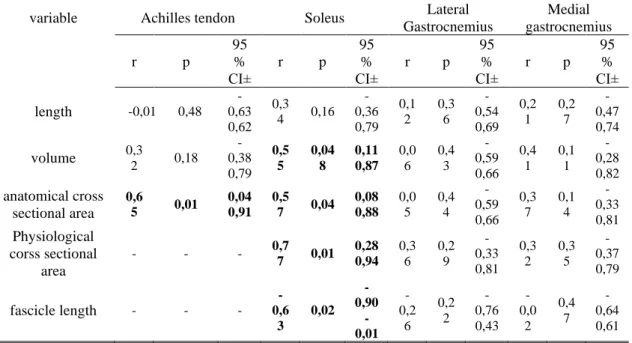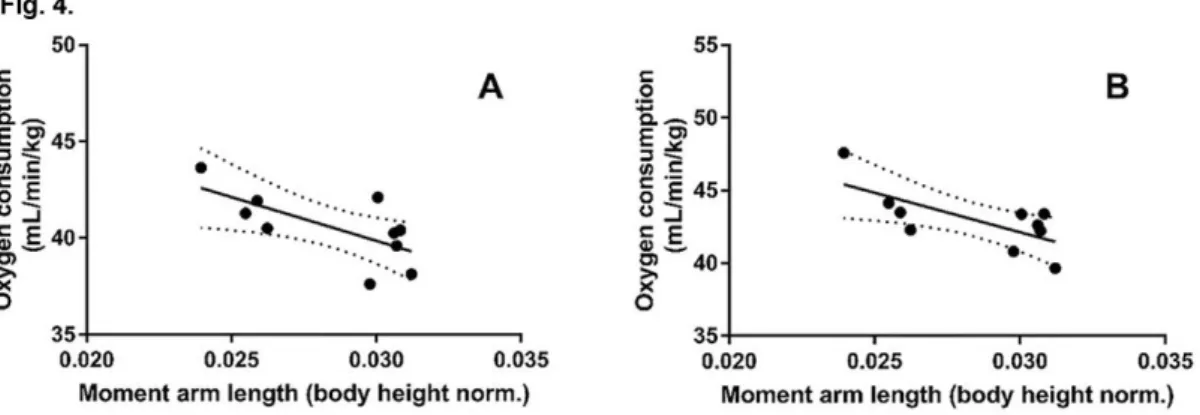THE EFFECTS OF ANKLE AND PLANTAR FLEXOR MUSCLES ON MOTOR PERFORMANCE
Abstract of PhD Thesis
Bálint Kovács
Doctoral School of Sport Sciences University of Physical Education
Supervisor: Dr. József Tihanyi rector emeritus, DSc
Official reviewers: Dr. Tamás Szabó university private professor, CSc Dr. István Karsai assistant professor, PhD
Head of the Final Examination Committee:
Dr. Gábor Pavlik professor emeritus, DSc
Members of the Final Examination Committee:
Dr. Rita Mária Kiss professor, DSc
Dr. Péter Osváth associate professor, PhD Budapest
2021
1 Introduction:
Most of human movement like jumping, hopping and running is influenced by several factors. The ankle joint plays an important role during hopping and running, because the muscles around the ankle joint producing the highest amount of muscle force necessary to propel the body upward and forward. Thus, the structure of the ankle must have an influence on motor performance. For example, the length of the Achilles tendon moment arm has an effect on the ratio of force production. Under similar contraction conditions a longer moment arm should result in smaller force production while maintaining the same joint torque therefore, it can decrease the metabolic energy consumption of the contractile elements. During hopping we can investigate this effect under a more controlled condition. There is no consensus in the literature results therefore these findings are often contradictory about the effect of the Achilles tendon moment arm on motor performance. Thus, the aim of our studies were to clarify how the Achilles tendon moment arm interacts with the function of the lower leg during hopping and running.
Hypothesis
I/a. We assumed that Achilles tendon moment arm is not a strong enough predictor of hopping height, but with other variables have a joint effect on hopping performance.
II/a We assumed that the characteristics of the soleus muscle shows stronger correlation than the parameters of the gastrocnemii muscles.
II/b We assumed that those runners who perform better in marathon they have greater anatomical and physiological cross-sectional area and shorter fascicle length of the soleus muscle.
II/c We hypothesized that a thicker Achilles tendon is linked with better marathon performance.
II/d We assumed that a greater muscle to tendon ration is correlated with superior marathon performance.
III/a We assumed that thus runners who have longer Achille tendon moment arm, they also have better running economy.
III/b We hypothesized that more economical runners have smaller EMG activity and smaller fascicle length changes which linked to smaller energy consumption.
2
III/c We assumed that longer Achilles tendon moment arm paired with less ankle dorsiflexion andplantarflexion during stance phase.
Methods:
Healthy young adults (n = 28, age 21.8 ±4.0 yrs.) performed serial hops on a force plate during which we recorded right leg joint kinematics, lateral gastrocnemius fascicle behavior, and plantar flexor electromyography activity.
Figure 1. Example set up of the measurment. 1. ultrasound 2. EMG electrodes 3. reflective markers 4. Forceplate
The right lower leg of ten male distance runners (29±3.8 years, 177.1±8.9 cm, 65.4±5.8 kg) was scanned with magnetic resonance imagining. The cross-sectional areas of the Achilles tendon, soleus, and lateral and medial gastrocnemius were measured, and the muscle volumes were calculated. Additional ultrasound scanning was used to estimate the fascicle length of each muscle to calculate the physiological cross-sectional area.
Ten male competitive marathon runners (29±3.8 years, 177.1±8.9 cm, 65.4±5.8 kg) volunteered for this study. The participants ran on a treadmill at two running speeds:
3 and 3.5 m s−1. During running the oxygen consumption, lower leg kinematics, electrical activity of plantar flexor muscles, and fascicle behavior of the lateral gastrocnemius were measured simultaneously. On the second occasion, an MRI scan of the right leg was taken and used to estimate the Achilles tendon moment arm length.
3
Figure 2. Measurement equipments mounted on a participant before the treadmill running test.
Results:
We found no correlation between hopping height and Achilles tendon moment arm (r=0.28, p=0.14). Multiple regression analyses revealed that variations in Achilles tendon moment arm, ankle dorsiflexion amplitude, and peak ground reaction force explained 53% of the variation in hopping height.
Figure 3. Correlation between Achilles tendon moment arm and hopping height (r=0.28, p=0.14). 95% CI was represented by the dashed line
4
Correlations were found between marathon running performance and soleus volume (r = 0.55, p = 0.048), soleus cross-sectional area (r = 0.57, p = 0.04), soleus physiological cross-sectional area (r = 0.77, p < 0.01, CI± 0.28 to 0.94), Achilles tendon thickness (r = 0.65, p < 0.01), and soleus muscle-to-tendon ratio (r = 0.68, p = 0.03). None of the gastrocnemius characteristics were associated with marathon performance.
Table 1. Correlation coefficients between marathon running performance and triceps surae muscle–tendon morphological characteristics.
variable Achilles tendon Soleus Lateral
Gastrocnemius
Medial gastrocnemius
r p
95
% CI±
r p
95
% CI±
r p 95
% CI±
r p 95
% CI±
length -0,01 0,48 - 0,63 0,62
0,3 4 0,16
- 0,36 0,79
0,1 2
0,3 6
- 0,54 0,69
0,2 1
0,2 7
- 0,47 0,74
volume 0,3
2 0,18
- 0,38 0,79
0,5 5
0,04 8
0,11 0,87
0,0 6
0,4 3
- 0,59 0,66
0,4 1
0,1 1
- 0,28 0,82 anatomical cross
sectional area 0,6
5 0,01 0,04
0,91 0,5
7 0,04 0,08 0,88
0,0 5
0,4 4
- 0,59 0,66
0,3 7
0,1 4
- 0,33 0,81 Physiological
corss sectional area
- - - 0,7
7 0,01 0,28 0,94
0,3 6
0,2 9
- 0,33 0,81
0,3 2
0,3 5
- 0,37 0,79
fascicle length - - - - 0,6
3
0,02 - 0,90
- 0,01
- 0,2
6 0,2
2 - 0,76 0,43
- 0,0
2 0,4
7 - 0,64 0,61
There was a negative correlation between running economy and the body height normalized moment arm length at both selected speeds (r = −0.68, P = 0.014 and r =
−0.70, P = 0.01). In addition, Achilles tendon moment arm length correlated with the amplitude of the ankle flexion at both speeds (r = −0.59, P = 0.03 and r = −0.60, P = 0.03) and with the electrical activity of the medial gastrocnemius muscle at 3 m s−1 speed (r=
−0.62, P = 0.02).
5
Figure 4. Correlation between body height normalized Achilles tendon moment arm length and oxygen consumption. (A) At 3 m s−1 running speed (r = −0.68, P = 0.01) and (B) at 3.5 m s−1 speed (r = −0.70, P = 0.01).
The fulfillment of hypotheses
I/a. We assumed that Achilles tendon moment arm is not a strong enough predictor of hopping height, but with other variables have a joint effect on hopping performance.
We accept this assumption since we failed to find correlation between moment arm length and hopping height, however a multiple regression model revealed a significant model explaining 53% of variation in hopping height including the moment arm length as an independent variable.
II/a We assumed that the characteristics of the soleus muscle shows stronger correlation than the parameters of the gastrocnemii muscles.
We accept this assumption since we found correlation between various soleus parameters and running performance, but not in the case of the gastrocnemii muscles.
II/b We assumed that those runners who perform better in marathon they have greater anatomical and physiological cross-sectional area and shorter fascicle length of the soleus muscle.
We accept this assumption because we found correlation between the aforementioned soleus parameters and running performance.
II/c We hypothesized that a thicker Achilles tendon is linked with better marathon performance.
6
We accept this assumption because we found a significant correlation between Achilles tendon cross sectional area and running performance.
II/d We assumed that a greater soleus muscle to tendon ration is correlated with superior marathon performance.
We accept this assumption because we found a significant correlation between soleus muscle to Achilles tendon cross sectional area and running performance.
III/a We assumed that those runners who have longer Achille tendon moment arm, they also have better running economy.
We accept this assumption because we found that the normalized (to body height) moment arm length is correlated with smaller oxygen consumption.
III/b We hypothesized that more economical runners have smaller EMG activity and smaller fascicle length changes which linked to smaller energy consumption.
We accept this assumption partially since we found that runner with better running economy have smaller EMG activity in medial gastrocnemius muscle, but there was no correlation between oxygen consumption and the rate of fascicle length changing.
III/c We assumed that longer Achilles tendon moment arm is coupled with less ankle dorsiflexion and plantarflexion during stance phase.
We accept this assumption since we found correlation between the Achilles tendon moment arm and ankle dorsiflexion and plantarflexion.
Conclusion/summary:
We demonstrated that the Achilles tendon moment arm length is not associated with hopping performance, therefore it is not strong enough predictor of the hopping height as we assumed. However, the moment arm affects variables which have strong correlations with hopping height (I) thus we can suggest an indirect effect of the moment arm on hopping performance supported by the results of the multiple regression model.
(II) We confirmed the recent literature results suggesting that soleus muscle plays a more determinant role during running compared to gastrocnemii muscles, since we found that various soleus parameters and running performance, but not in the case of the gastrocnemii muscles. (III) We found that the soleus to Achilles tendon cross sectional ratio is related to running performance which is a novel finding.
7
Our results indicate that a longer Achilles tendon moment arm can decrease the oxygen consumption during moderate running speed, thus it can be beneficial in running economical point of view. Also, (IV) the moment arm length can alter the amount of joint rotation and muscle function thus it can modulate the energy consumption of running. We can conclude that (V) a greater soleus muscles with a thick Achilles tendon coupled with longer Achilles tendon moment arm can be beneficial for Caucasian runners.
8 Published articles related to the thesis:
1. Kovács B, Kóbor I, Gyimes Zs, Sebestyén Ö, Tihanyi J. (2020) Lower leg muscle–
tendon unit characteristics are related to marathon running performance. Sci Rep, 10:
17870
Impact factor: 4,379
2. Kovács B, Kóbor I, Sebestyén Ö, Tihanyi J. (2021) Longer Achilles tendon moment arm results in better running economy. Physiol Int, 107: 527-541.
Impact factor: 2,09
3. Kovács B, Sebestyén Ö, Tihanyi J. (2021) Lower leg characteristics influance on hopping height. APH, 18: 155-171.
Impact factor: 1,806
Published articles unrelated to the thesis:
4. Hegyi A, Csala D, Kovács B, Péter A, Liew BXW, Yue Y, Finni T, Tihanyi J, Cronin NJ. (2021) Superimposing hip extension on knee flexion evokes higher activation in biceps femoris than knee flexion alone. J Electromyogr Kinesiol, 58: 102541
Impact factor: 2,368



